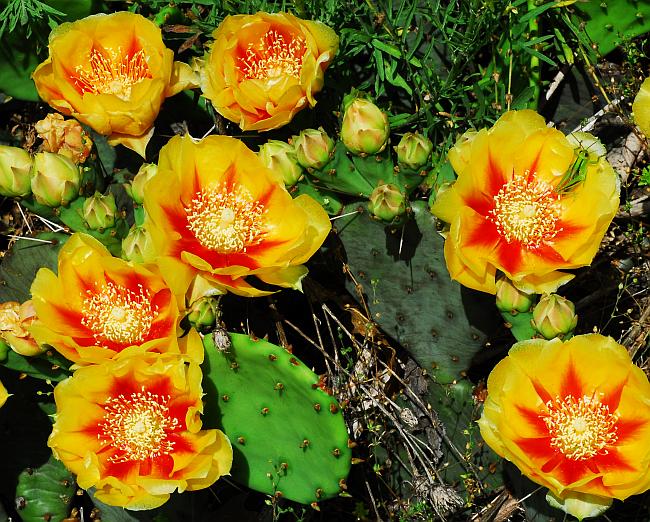Opuntia cespitosa Raf.
Eastern Prickly Pear

Native
CC = 4
CW = 5
MOC = 46
© SRTurner
Opuntia cespitosa Raf.Eastern Prickly Pear | |
 |
Native CC = 4 CW = 5 MOC = 46 |
© SRTurner |
|
Family - Cactaceae Habit - Succulent, sprawling shrub with somewhat woody rootstock. Stems - Highly modified into thick, flat pads (cladodes), often in chains of 2-6, often produced with the flat side parallel to the ground, obovate, rotund, or elliptical in outline, strongly glaucous-green when developing, aging dark green or light gray-green, cross-wrinkling during the winter months, 4-19 cm x 3-11 cm, 4-19 mm thick, with 4-6 (generally 5) areoles per diagonal row. Leaves glaucous, ascending parallel to the pad surface or slightly spreading, 5.5-6.8 mm long.
Spines - Spines smooth to the touch, 1-2 per areole (most commonly 1), 1.5-4.3 cm long, 0.78-0.87 mm in diameter, these dark at the base during development but maturing bony-white, and finally dark gray in age, typically spreading in one plane from the areoles (i.e., in line with one another) with primarily 1 spine, or occasionally 2 of roughly the same length or 1 long and 1 short and slightly deflexed, rarely 3 spines produced from the areoles; in age the mid-cladode and especially the basal cladode spines tend to deflex. Glochids 2-3 mm long, dark red or amber, aging light to dark brown.
Flowers - Outer tepals triangular to ovate, inner tepals 9-10, 3-6 cm long, basally tinged reddish, orange, or reddish-pink, obovate with a mucronate tip, filaments yellow, reddish basally, stigmas white to cream with 6-10 lobes.
Fruits - Berries 2-5 cm long, the surface with glochids but no spines, the areoles sometimes restricted to the apical rim, remaining fleshy with age, green, sometimes becoming reddish-or purplish-tinged with age. Seeds 3.5-4.5 mm long, the raised rim relatively short (extending about 0.5 mm beyond the seed body) and smooth.
Flowering - May - July. Habitat - Glades, prairies, bluffs, stream terraces, pastures, railroads, open disturbed areas. Origin - Native to U.S. Lookalikes - Other species of Opuntia Other info. - This cactus is by far the most widespread species of Opuntia in Missouri, common throughout most of the state. It occurs throughout most of the eastern half of the continental U.S., though uncommon to rare in northern regions. Prickly pear cactus is easily identified to genus by its appearance, though differentiation of species can be difficult. Photographs taken at Greensfelder Park, near Pacific, St. Louis County, MO, 5-23-2009, along the Al Foster Trail near Glencoe, St. Louis County, MO, 4-17-2010, at Sand Prairie Conservation Area, Scott County, MO, 9-24-2011, St. Joe State Park, St. Francois County, MO, 6-10-2013, and on Ellis Island, near West Alton, St. Charles County, MO, 7-3-2017 (SRTurner). |